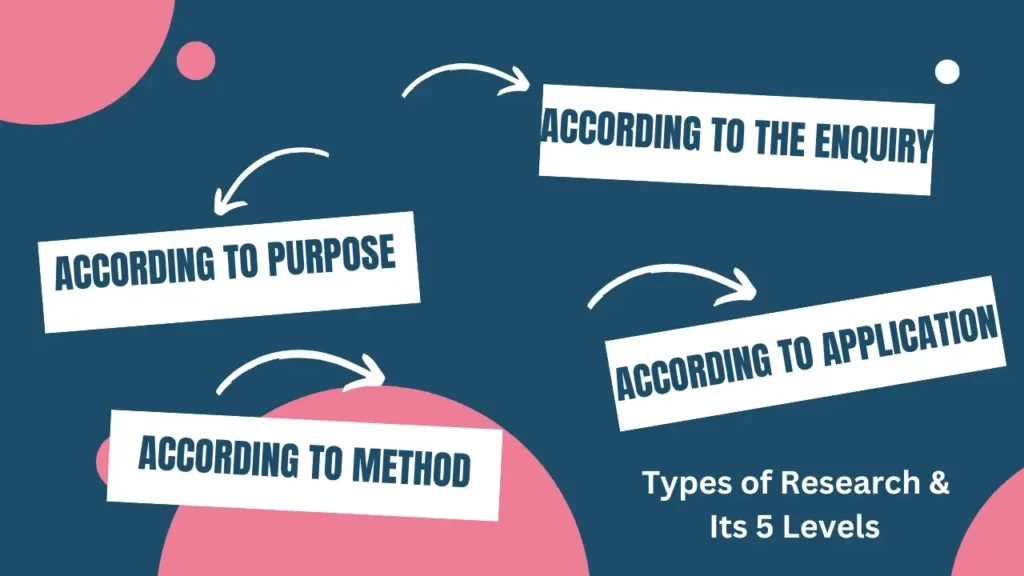A. According to Purpose
There are three primary types of scientific study purposes: exploratory, descriptive, and explanatory.
Exploratory Research
Exploratory research is typically conducted in new fields of inquiry to comprehend the extent or magnitude of a certain phenomenon, issue, or behavior. It aims to produce preliminary insights or hypotheses on the phenomena or to evaluate the feasibility of doing a more comprehensive research on the topic.
For instance, if the citizens of a country are predominantly dissatisfied with governmental policies during an economic recession, exploratory research may concentrate on quantifying the extent of citizen dissatisfaction, identifying the various ways of expression for this discontent, such as public demonstrations, and determining the probable origins of this dissatisfaction, including inadequate governmental measures concerning inflation, unemployment, interest rates, or higher taxation.
This study may not yield a precise understanding of the main problem; yet, it remains useful in evaluating the nature and extent of the problem. It might function as a beneficial initial phase prior to undertaking more extensive study. Exploratory research is conducted in situations where the subject matter is novel, lacking in information, and has not been previously investigated. Our objective is to develop more specific inquiries that we can focus on in future research.
During the initial phase of the investigation, our goal is to gather sufficient information from the exploratory study in order to plan and conduct a more comprehensive and methodical study. Exploratory research seldom produces definite results. It investigates the key question: what is the genuine goal of this social activity? This activity might be difficult to do because there are few criteria and everything has the potential to be important.
The phases are not well defined, and the direction of investigation changes often. Researchers who perform exploratory research should be creative, open-minded, and flexible. They should approach their task with an open-minded attitude to look into all possible sources of information. They provide thought-provoking questions and recognize the importance of unknown or random circumstances that might have big consequences.

For example, the idea that immigration’s impacts on younger children in a new nation may be more harmful than those on older children. Surprisingly, children aged six to eleven who immigrate are more likely to experience disruption than younger children.
Key Features
- Gain a thorough understanding of the major facts, problems, and setting.
- Develop a broad understanding of the situation
- Formulate and enhance inquiries for subsequent research
- Develop novel concepts, theories, or hypotheses
- Assess the practicality of carrying out research
- Develop methodologies for the measurement and localization of new information.
Qualitative data is commonly used in most exploratory research. Typically, qualitative research is more open to incorporating diverse evidence and uncovering new issues.
Descriptive Research
A phenomena is carefully observed and documented in descriptive study. These observations should follow the scientific process for replicability and accuracy. Thus, they are more dependable than untrained observations. Demographic statistics are used by the Bureau of Labor for descriptive research. They assess sector employment and ethnicity population growth across surveys and censuses using the same techniques.
We provide estimates that encompass and exclude the modifications to the measuring instruments. This lets readers compare population or employment patterns before and after changes. You might possess a deep comprehension of a social phenomenon and desire to describe it. Descriptive research offers an in-depth perspective on the complex elements of a situation, social environment, or relationship.
A considerable amount of the social research published in academic journals or utilized for policy-making is descriptive in nature. Descriptive and exploratory research frequently connect in application. A descriptive research study starts with a well-defined issue or question and seeks to deliver an accurate illustration of it. The results of the study offer a thorough insight into the problem or the answer to the research question.
For example, one might explore the relationship between parents who drink heavily and instances of child abuse. The results showed a significant difference in the extent of physical abuse between parents who drink a lot and those who either don’t drink at all or drink in moderation. In particular, just 5 percent of parents who either never drink or drink very little were found to have physically harmed their children, compared to 25 percent of parents who drink often.
A descriptive research examines “how” and “who” while offering a thorough perspective on different people or social activities. And who is involved? It is more important to describe the current state of affairs than to comprehend the underlying reasons of some actions, such as the mistreatment of children by parents who drink excessively.
The description of different phenomena is the main focus of a large portion of social research. A range of data-gathering methods are used by descriptive researchers, such as surveys, content analysis, field research, and historical-comparative studies.
Key Features
- Offer a comprehensive and precise picture
- Find new information that contradicts previous data
- Develop a system of categories or categorize various types
- Provide a clear outline of the steps or stages
- Describe a cause-and-effect process or mechanism
- Provide an overview of the background or context of a situation
Explanatory Research
Explanatory study seeks to explain observable occurrences, problems or behaviors. It tries to clarify the relationships in research by recognizing the causal factors and consequences of the target phenomena. Examples include understanding the root causes of juvenile delinquency and striving to formulate effective methods to tackle these societal challenges. Most academic or doctorate research predominantly falls into the explanatory category, but there may be a necessity for exploratory and/or descriptive research during the first phases.
Understanding and interpreting observable phenomena necessitates theoretical knowledge, interpretive abilities, intuition, insights, and personal experience. The scientists capable of doing this excel in their disciplines and are much esteemed. When encountering a familiar issue accompanied by a clear explanation, it is instinctive to consider the underlying causes of the present circumstances. The aim of explanatory research is to explore the reasons behind a specific phenomenon.
It employs exploratory and descriptive research methods to gain a deeper understanding of the reasons behind specific events. An explanatory study delves into the underlying causes and reasons, going beyond merely presenting a picture of the issue. For example, a descriptive study would concentrate on recording the number of parents who involve in heavy drinking and mistreat their children, whereas an explanatory study would seek to comprehend the fundamental reasons for this abusive conduct.
We explore the particular elements that connect heavy drinking to child abuse. We employ a range of methods in explanatory research. In specific explanatory studies, a new explanation is developed and then supported or refuted with empirical evidence. In other studies, we offer various competing explanations and supply evidence for each, facilitating a comprehensive comparison to assess their relative strengths.
In certain instances, we start with an established explanation rooted in social theory or earlier studies and subsequently broaden it to tackle a different issue, context, or demographics in order to evaluate its validity or find any required modifications or limitations.
Key Features
- Test theory predictions or principles.
- Expand and improve theoretical explanation
- Apply theories to new areas
- Examine or question an explanation or estimate
- Apply a broad principle to problems.
- Choose the best explanation from various alternatives.
The primary goal of explanatory research is to provide explanations for the occurrence of events and to further develop, expand, or test theories.
B. According to the Enquiry
There are various other types of research which are discussed below:
Historical Research
This one of the types of research that involves carefully analyzing past events to uncover the truth. Historical research is usually carried out by a single person and often does not include the development of a hypothesis. This approach offers insights to address current challenges based on past events.

Ex-Post-Facto Research
This research often investigates the varied effects of two identical variables. Two variables will be present: the independent variable and the dependent variable. This study will draw upon previous knowledge. In order to truly understand the potential effects of English and Urdu education in the future, it is crucial to thoroughly analyze past events and factual information.
Experimental Research
This approach involves obtaining information by gathering fresh observations under controlled settings. It reveals the correlation between factors and the effects they have. Carefully observing and accurately documenting data are essential tasks in this research. There are two types of experiments: laboratory and field experiments.
Field Research
In this study, the investigator carefully selects participants of the study and monitors their behaviors. This method sets the field experiment study with respect to the design of the research. Being an administrator and investigator is essential for a field researcher, as it allows for effective management of feasibility, cost, and time distribution in field research. Field research encompasses several methodologies, including participant observation, ethnography, and in-depth interviews.
C. According to Application
Pure / Basic research
The formulation of scientific hypotheses or foundational concepts is referred to as pure, basic, or fundamental research. It offers essential knowledge for the discipline.
Key Features
- It offers an initial foundation for further study.
- It involves uncovering new facts without proper verification.
- It gives a clear definition of a topic. It provides a clear direction for action.
- It provides different approaches to addressing social problems.
Applied Research
In applied research, a problem is recognized, and the outcomes are anticipated to enhance practices aimed at resolving issues that yield concrete benefits. According to Johada, “Applied research is not concerned only with the theoretical relationship among variables, but these are empirically tested in the field.
Key Features
- It examines and tests theories.
- It uncovers new facts.
- It focuses on the cause and effect of social events.
- It offers a prompt response to a question.
- The information transforms from broad to specific topics.
- It focuses on promoting social welfare.
Action Research
This study is focused on practical application and implementation on an immediate basis. This one of the types of research in which the researcher takes on the role of a participant observer and actively engages with the results and their practical implications. Action research is valuable for addressing local problems within a specific community. Immediate solutions are the focus of action research, addressing any problems that need to be resolved.

Key Features
- Utilizing action research can greatly contribute to informed decision-making.
- It expands one’s knowledge base.
- It is beneficial for putting research findings into action.
- It introduces an experimental perspective.
Evaluation Research
This one of the types of research that primarily focuses on assessing the effectiveness of programs that have been implemented to attain a specific goal. Evaluation is a process that involves assessing the final product and the impact of an activity in relation to the declared objectives of the program. Three categories of evaluation exist.
- Concurrent evaluation means a continuous process.
- Basic or periodic evaluation means stage-wise.
- Terminal evaluation means evaluation after the completion of the program.
Interdisciplinary Research
It involves examining the structure and function of a specific discipline or comparing it to another. It is also known as coordinated research.
Key Feature
- This is a collaborative project.
- It helps to study the phenomena as a whole.
- It presents an approach to compare the efficiency of various disciplines.
D. According to Method
Qualitative Research
In qualitative research, data is collected and subsequently analyzed. Information is easily available in society. Both inductive and deductive methods are utilized. Information is gathered through careful observation and then analyzed through interviews to reach a conclusion. For this type of research, there are no specific guidelines instead, the researcher must rely on their own powers of observation and analytical thinking when conducting qualitative research.
Quantitative Research
It is also known as a statistical method. The data is carefully measured, focusing only on units that can be easily quantified. It focuses solely on numerical data, rather than addressing the underlying causes of the issue.
Mixed-method Research
It is also one of the types of research that combines both i.e., qualitative and quantitative research. Few part of the study is qualitative while other one is quantitative.
E. According to Time and Dimensions:
Types of research emphasize on the purpose, methodology and approaches of data collection, while levels of research focus on strength and quality of facts. Here we present five major levels of research:
Micro-Study
An understanding of social life at a small level/unitary level e.g. examining how the playing behavior of girls is different from that of boys.

Macro-Study
An understanding of social life at a large level even at the level of the whole society e.g. Karl Marx’s examination of the class struggle is an example of macro-study.
Longitudinal Study
A study design in which data is obtained from the same individual two or more times during a specific period of time (usually of considerable length such as several months or years). It is further sub-divided into:
Cohort Study
In a cohort study, a researcher investigates the evolution of specific subpopulations, or cohorts, over time.
Trend Study / Time series Research
Examines the changes within a given population over time. Compiling a cross-sectional picture of the trends being observed at different points in time over the past, present, and future and draw conclusions about the pattern of change.
Panel Study
Examines the same set of people each time. These are prospective in nature and are designed to collect information from the same respondents over a period of time.
Cross-Sectional Study
This process involves making observations of a sample or cross-section of a population or phenomenon at a single point in time. e.g. study of political activities exactly 15 days before a forthcoming general election in Pakistan.
Pilot Study
A small-scale study conducted prior to the conducting of the actual and complete study; its purpose is to reveal defects in the research plan.






